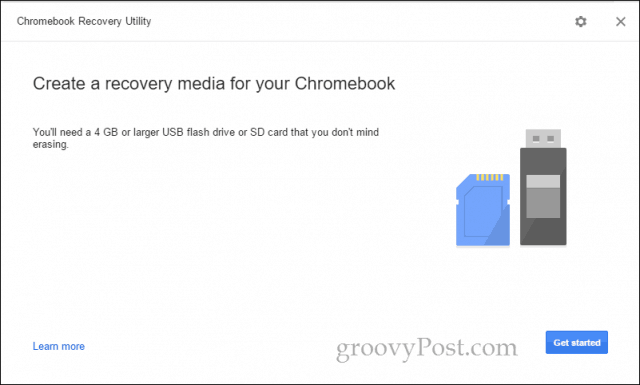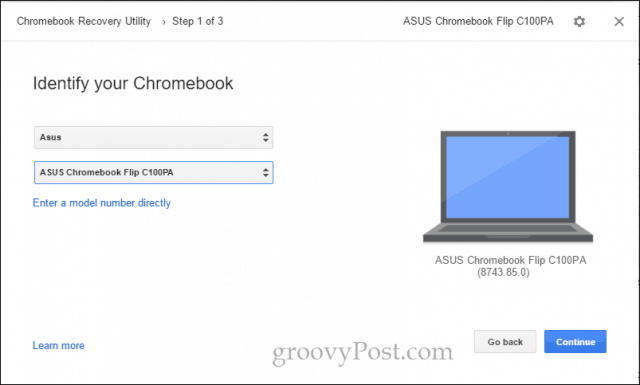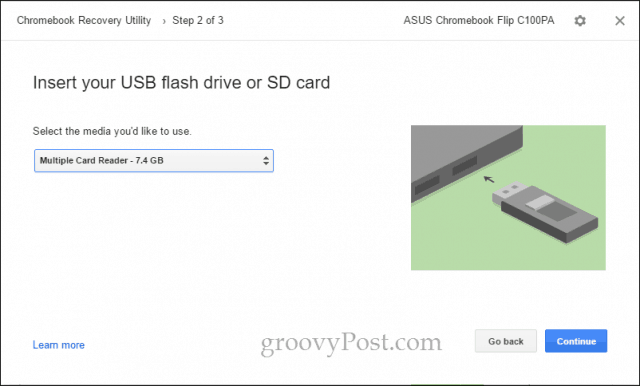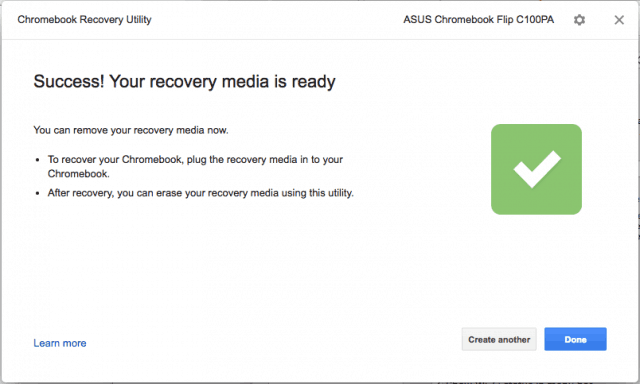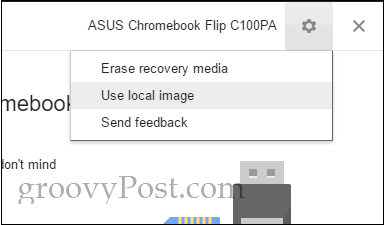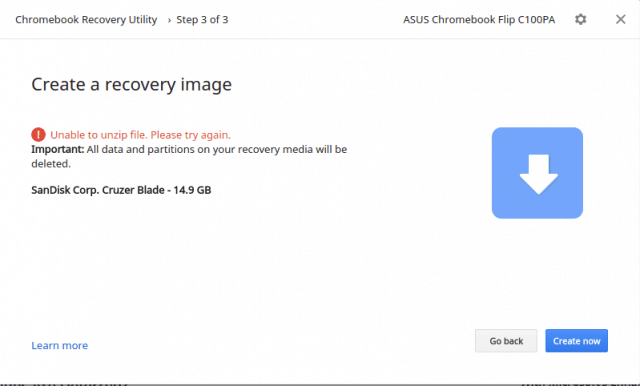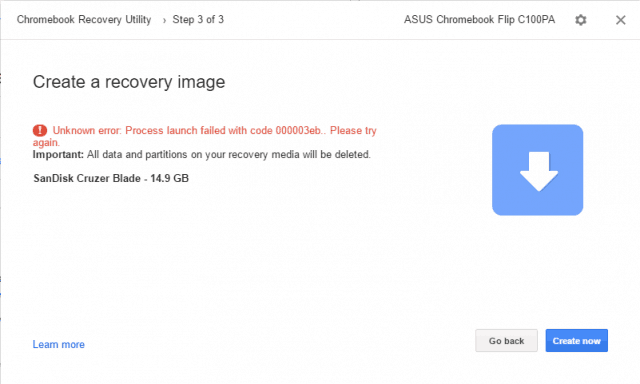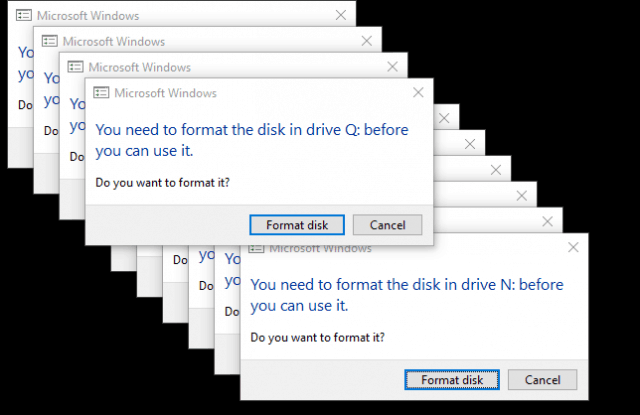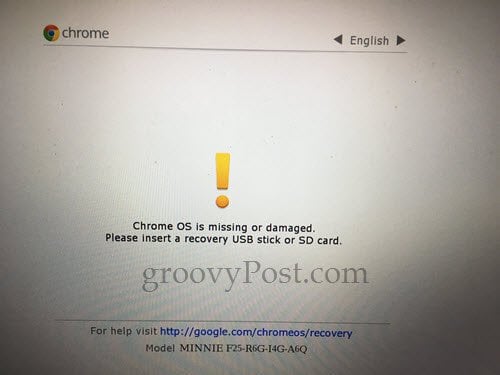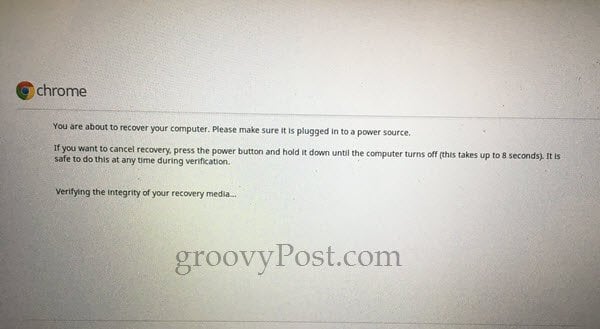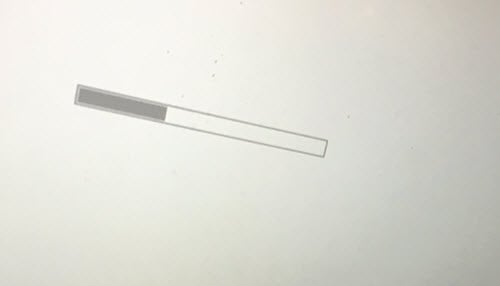There’s one small problem: the Chromebook Recovery Utility is kind of a pain in the neck. It took me multiple tries on multiple computers with multiple USB drives and SD cards to get it to work. In this walkthrough, I’ll try to guide you around some of the stumbling blocks I encountered. Note: Previously, you could make Chromebook recovery disks by using chrome://imageburner. The Chromebook Recovery Utility replaces this.
How the Chromebook Recovery Utility Works (Sometimes)
The process for creating a Chromebook Recovery Utility is supposed to be foolproof. You can do this on your Chromebook or another computer, like a Windows PC or a macOS computer. This method worked flawlessly for me on macOS 10.12.2 with a SanDisk 8 GB SD card. Here’s how it goes normally: Now you can remove your recovery media and store it in a safe place until it’s time to recover your Chromebook (hopefully never!).
Alternate Method for Making a Recovery Disk with Chromebook Recovery Utility
The normal method for creating a USB Chromebook Recovery drive did not work for me on my Windows 10 laptop or Chromebook. I did eventually get it working using the two advanced options in the utility: Erase recovery media and Use local image. Note: To find the local image, I went to this website: My Chrome Home. I know that blog looks kind of shady, but the direct links they provide go to dl.google.com which is legit Google server. They’ve just done the work of guessing or reverse engineering the actual locations where the utility is downloading the images from. If in doubt, after your image is done downloading, press CTRL + J and confirm on the downloads page that the zip file came from google.com.
This worked for me on my Windows 10 PC with a SanDisk 8 GB SD card when nothing else would. Oddly enough, after I did this successfully, it worked using the normal method without a hitch using my SanDisk 16 GB Cruzer Blade USB. It’s possible that this is a network connectivity issue and something has gone awry with the built-in Chromebook Recovery Utility Downloader. Some users have reported success by disabling their antivirus programs when downloading the image. If you are still having issues, read on. If not, skip down to how to use your Chromebook recovery media.
Error: Unable to unzip file. Please try again.
I encountered this when using a SanDisk Cruzer Blade 16 GB on my ASUS Chromebook Flip C100PA. I never found a solution. It may have been a failed download or insufficient space on my Chromebook’s storage drive. But I never got to the bottom of this and just used a Macbook Air instead.
Unknown error: Process launch failed with code 0000003eb. Please try again.
I encountered this when trying a Kingston DataTraveler 4 GB and my SanDisk 16 GB USB and my SanDisk 8 GB SD card on my Windows 10 PC.
Solution: I got this working on my Windows 10 PC by using the Erase recovery media and Use local image options (see above). Notably, when I used these options, I was prompted by the User Account Control (UAC) window during both of these steps. I think this might be a clue about the underlying issue. On a hunch, I tried running the Chromebook Recovery Utility as an administrator to see if it solved the problem, but it didn’t. So far, the only method that has worked for me is to use a local image as described in the steps above.
I can’t use my USB drive after attempting to use Chromebook Recovery Utility
The Chromebook Recovery Utility makes some pretty radical changes to your USB drive to prepare it for use as ChromeOS recovery media. If you want to use the full capacity of your drive for normal purposes again, use the Chromebook Recovery Utility to erase the drive. See the steps above (just stop before applying the local image).
I get like a million messages saying “You need to format disk in drive X: before you can use it.”
Yeah, me too. I think it’s just a quirk of how Windows detects the drives before writing to them. You can close them all at once by right-clicking the File Explorer icon on your taskbar and clicking Close all windows. After this had happened to me, I had a bunch of phantom USB drives showing up in File Explorer with those drive letters. They even persisted after I erased the drive, removed the drive, and rebooted my computer. I reinserted the drive, ejected one or two and removed the drive and it got rid of them. Pretty weird.
How to Recover a Chromebook Using a ChromeOS Recovery Media
Assuming you created the recovery media without issue, here’s what you do if you get the dreaded “Chrome OS is missing or damaged” error. Here are some of the screens I saw when I recovered. Here’s the “Chrome OS is missing or damaged. Please insert a recovery USB stick or SD card” screen. You can change the language in the top-right. The model number is at the bottom. You can use this when downloading your image.
Once you plug in your recovery USB, it automatically begins verifying the image.
The first time I went through the process, I got this error: “An unexpected error has occurred. Please refer to this URL for troubleshooting tips: https://www.google.com/chromeos/recovery”. I re-made my recovery media, and it solved the problem.
During my successful recovery, I got this blank progress bar. I don’t know if this is normal, but it worked fine.
The next screen says: “System recovery is in progress…” The process took about five minutes.
At the “System recovery is complete” screen, you’ll be prompted to remove the recovery media. Your Chromebook will reboot automatically, and it’ll be like you just took it out of the box.
Conclusion
So, there you have it. The quick and easy Chromebook Recovery Utility is extremely obnoxious and flaky, at least as of the time of this writing. Considering the following if you are struggling:
The utility is picky about what kind of media you use. Some say SanDisk drives won’t work, and I thought that was my problem at first. But I did eventually get it to work on a SanDisk Cruzer USB stick and a Sandisk SD card.You’ll have better luck if you format the drive using the Chromebook Recovery Utility first.You’ll also have better luck if you download your image separately and apply it with the Use local image option. See above for those instructions.When downloading using the Chromebook Recovery Utility, make sure you have a good connection, and your antivirus is temporarily disabled.If you get this to work on a Chromebook (i.e. make a Chromebook recovery USB drive on a Chromebook), then let me know. I’ve only gotten it to work in Windows and macOS.
Have you had any luck with the Chromebook Recovery Utility? Have you ever legitimately needed a Chromebook recovery drive? Tell me about it in the comments! – Normal recovery process doesnt work at all, due to problems while downloading Search ( + )by platform or model number and look in the Recovery column for the links. As an example, my model, Acer R11, has all the images back to release 67. The current release is 80.0.3987.137. Clicking on the “79” link downlods the file chromeos_12607.81.0_cyan_recovery_stable-channel_mp-v3.bin.zip Comment Name * Email *
Δ Save my name and email and send me emails as new comments are made to this post.
![]()

